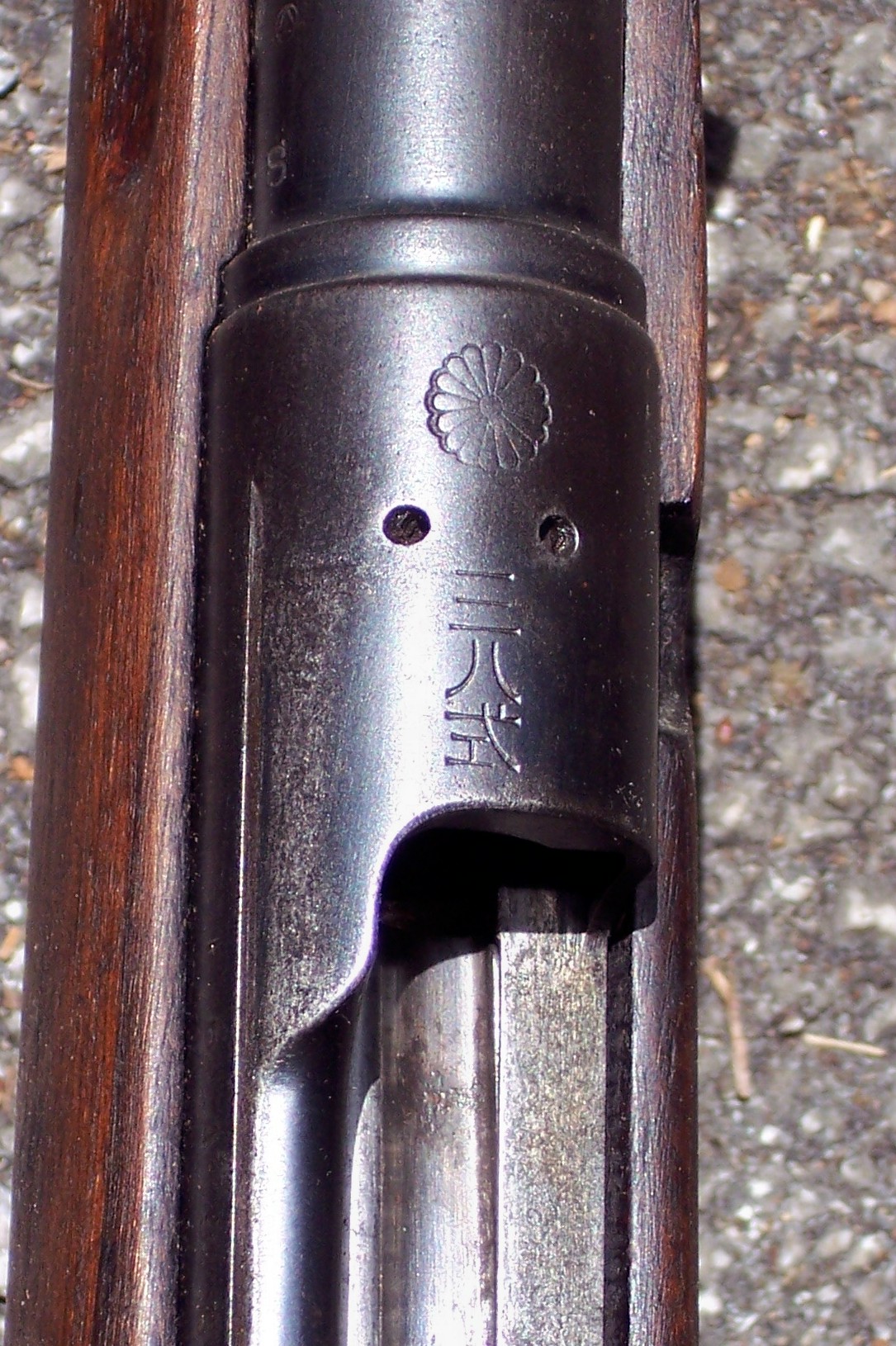
- The Type 99 was produced in four versions, the regular issue Type 99 Short Rifle, the Type 99 Long Rifle (a limited production variant), the take-down Type 2 Paratroop Rifle, and the Type 99 Sniper Rifle. The standard rifle also came with a wire monopod and an anti-aircraft sighting device. The Type 99 was the first mass-produced infantry rifle.
- The Model/Type markings are generally found on the top of the receiver, forward (towards to muzzle) of the chamber and generally indicate original caliber unless modified by another country at a later date. The serial number is found on the left side of the receiver on most standard rifles. The Arsenal mark on Japanese rifles is generally found to the right of the serial number on the left.
CASTLE-THUNDER.COM Rifles - Back to Main Page
Receiver Markings Japanese Rifles 1897-1945
Model: Arisaka, Type 99 Serial Number: 4578 Year of Manufacture: 1939 - 1945 Caliber: 7.7x58mm (7.7 Jap) Action Type: Bolt Action, Internal Magazine Markings: There is no visible import mark.
Modern Japanese rifles were produced in various configurations and calibers at several Arsenals located thoughout Japan, China, and Korea from about 1897 through 1945. Below are the markings on rifles in 6.5 Japanese Caliber manufactured from 1897 until the mid 1940's. These rifles include: The Type 30 Long Rifle and Carbine, the Type 35 Rifle, the Type 38 Long Rifle, Short Rifle, and Carbine, the Type 44 Carbine, the Type 97 Sniper Rifle, and the Italian Type I Long Rifle.
6.5 Caliber Japanese Rifle Receiver Markings
Type 30 - Model of 1897 Found in Long Rifle and Carbine configurations |



Type 35 - Model of 1902 Found in Long Rifle Configuration only adopted for Naval use |
Type 38 - Model of 1905 Found in Long, Short Rifle, and Carbine Configurations | Type 38 - Model of 1905 Double Circle Rifle or Concentric Circle Rifle | Type 38 - Model of 1905 'Love of Country' marks either side of Chrysanthemum | Mexican Type 38 - 1913 Rifle/Carbine configuration No Type/Arsenal markings |
Type 44 - Model of 1915 Found in Carbine Configuration only 3 Variations Identified by Bayonet Housings |
Type 97 - Model of 1937 Kokura Arsenal Sniper Configuration only | Type 97 - Model of 1937 Nagoya Arsenal Sniper Configuration only |
In the late 1930's the Japanese developed a rifle to compete in 'Modern Warfare'. It was a redesign of the Type 38 in a larger caliber, 7.7 Japanese. These rifles include: The Type 99 Long Rifle, the Type 99 Short Rifle, the Type 99 Carbine, the Type 99 Naval Special, the Type 100 Paratroop Rifle, and the Type 2 Paratroop Rifle. Receiver Markings of the 7.7 Caliber guns are below.
7.7 Caliber Japanese Rifle Receiver Markings
Early Type 99 - Model of 1939 Found in Long/Short Rifle and Carbine configurations | Late Type 99 - Model of 1939 Double Circle Rifle or Concentric Circle Rifle | Late Type 99 - Model of 1939 Last Ditch Receiver markings Found on Short Rifles & Carbines | Naval Type 99 - Model of 1939 Naval Receiver markings Found on Short Rifles & Carbines |
Type 2 - Model of 1942 Found in Short Rifle configurations |

Type 99 Arisaka Serial Numbers
The Model/Type markings are generally found on the top of the receiver, forward (towards to muzzle) of the chamber and generally indicate original caliber unless modified by another country at a later date. The serial number is found on the left side of the receiver on most standard rifles. The Arsenal mark on Japanese rifles is generally found to the right of the serial number on the left side of the receiver. Frequently there is a Series designator in a circle preceeding the serial number on the left side of the action.
CASTLE-THUNDER.COM - Back to Home Page
Some graphics courtesy Hipp'os-sible Productions®©Copyright 2002-2004. Banzai Bomber and Friends®Japanese Bayonets Serial Numbers
Jan 02, 2019 The Arisaka Type 99 - Early war vs. Late war - a comparison. In recent months I have heard a GREAT MANY oft-repeated but factually wrong myths perpetuated about the Type 99 rifle and the supposedly dangerously unsafe 'last ditch' Type 99. 1500m was a nonsensical leftover from the Russo-Japanese war when area-fire machine-guns had yet to. For reference, the first Type 99 series production began at Nagoya in August, 1939. Cara download buku berbayar playstore gratis. Here is a photo of an early Type 99, a 31st series Toyo Kogyo Type 99 made in 1940 (on top) compared to a 7th Series Nagoya late war rifle made in 1944. The bayonets shown with each rifle are of the proper vintage for that rifle. Avengers 2012 movie kickass torrent download.
Japanese Arisaka Serial Number Database
Hi,
My lady has an Arisaka rifle that she inherited from an uncle who has since passed. The story I got was that the uncle had picked up the rifle while on occupation duty.
I believe that it's a Type 98, but it has VERY few markings. There's no sign of a chrysanthemum on the receiver (or any other identifying mark) nor does it seem to have been removed. The only markings I've found are '30' near where the serial number should be and 579 on the stock.
The rifle is about 50 1/2 inches long, the peep/ladder sight is graduated from 3 to 17 (no wing extensions) and the front sight is a single blade. The dust cover is still present. The stock and metalwork all appear to be well manufactured and finished.
I'm not sure of the caliber but according to my gauge, the muzzle is approximately 7mm in diameter.
I can provide pictures upon request.
Thanks,
Kit



